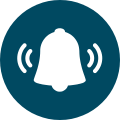
Nuestra visión:
Un condado de Kitsap seguro y saludable para todos.
Manejo de casos de niveles de plomo en sangre
Para informar una condición de declaración obligatoria o comunicarse con el equipo de Enfermedades Transmisibles del Distrito de Salud Pública de Kitsap, llame al 360-728-2235 o envíe por fax un formulario de fax completo a nuestra línea de fax confidencial: 360-813-1168.
Formularios de notificación de enfermedades
Lista de condiciones notificables
Anthrax (Bacillus anthracis, confirmed Bacillus cereus)
Report to:
Kitsap Public Health
Immediately (upon clinical suspicion)
Botulism (foodborne, infant, wound)
Report to:
Kitsap Public Health
Immediately (upon clinical suspicion)
Burkholderia Infection (Melioidosis or Glanders)
Report to:
Kitsap Public Health
Immediately (upon clinical suspicion)
Carbapenem-resistant Enterobacteriaceae (CRE)
and Organisms
Report to:
Kitsap Public Health
Within three business days
Disease Outbreaks (e.g., norovirus)
Report to:
Kitsap Public Health
Immediately (upon clinical suspicion)
Haemophilus influenzae (Invasive Disease children under five years of age)
Report to:
Kitsap Public Health
Immediately (upon clinical suspicion)
Human Immunodeficiency Virus (HIV) Infection
Report to:
Kitsap Public Health
Within three business days
Meliodosis (Burkholderia pseudomallei)
Report to:
Kitsap Public Health
Immediately (upon clinical suspicion)
Paralytic Shellfish Poisoning (PSP)
Report to:
Kitsap Public Health
Immediately (upon clinical suspicion)
Shiga Toxin-Producing E. coli (STEC)
Report to:
Kitsap Public Health
Immediately (upon clinical suspicion)
No result found. Please try a different search term or filter.
Healthcare Advisories
No result found. Please try a different search term or filter.
Enfermedades y temas de interés
Esta lista proporciona recursos para enfermedades y problemas de salud que los programas de Salud Pública de Kitsap están abordando en nuestro condado. Para obtener más información sobre nuestra labor de prevención, consulte las páginas temáticas y los avisos que aparecen en los enlaces a continuación o llámenos al 360-728-2235.
Recursos:
Kitsap Public Health can provide case management for patients with elevated blood lead levels. To learn more, visit our Blood Lead Level Case Management page or call 360-728-2229.
More resources:
Recursos:
El programa Nurse-Family Partnership ofrece visitas gratuitas de enfermeras durante el embarazo y los dos primeros años de vida del bebé. Para obtener más información, visite nuestra página web de NFP para profesionales de la salud o llame al 360-728-2229 .
Recursos:
Programa de Monitoreo de Recetas | Departamento de Salud del Estado de Washington
Línea directa para proveedores de tratamiento del dolor y opioides | Universidad de Washington
Recursos:
Recursos:
Guía para la notificación e investigación de la tuberculosis | Departamento de Salud
Proyecto TB ECHO | Departamento de Salud
Kit de herramientas sobre tuberculosis para profesionales sanitarios | Departamento de Salud
Capacitación básica sobre tuberculosis para trabajadores de la salud | CDC
Registro de la prueba cutánea de tuberculosis | Departamento de Salud
Datos sobre tuberculosis | CDC
Presentación de KPHD, junio de 2024
Recursos:
Programas estatales de vacunación:
Recomendaciones sobre la vacunación:
CENTROS PARA EL CONTROL Y LA PREVENCIÓN DE ENFERMEDADES:
Tableros de datos de enfermedades transmisibles

Data dashboards are not available on mobile devices. Please switch to a computer to view these dashboards.
Datos de enfermedades transmisibles de los condados de Kitsap, Clallam y Jefferson, compilados por los CDC, el Departamento de Salud de Washington y fuentes locales.
Más datos e informes de salud
Nota: Esta página proporciona información para profesionales de la salud. Los miembros de la comunidad pueden visitar nuestra página principal de Recursos sobre Plomo para obtener información general.
Conectarse con los servicios
¿Tiene un paciente con un nivel elevado de plomo en la sangre o desea obtener más información?
Llame a nuestra línea de apoyo para el embarazo y la crianza al 360-728-2229
Nuestro equipo de gestión de casos de nivel de plomo en sangre hará un seguimiento para brindar:
Orientación para su clínica sobre pruebas de confirmación y seguimiento.
Educación a la familia sobre cómo prevenir la exposición al plomo.
Pruebas caseras para identificar fuentes de exposición al plomo.
Información general
La exposición infantil al plomo es un problema de salud pública ambiental grave, pero prevenible. El plomo es una toxina que puede tener efectos a largo plazo en la salud física y el desarrollo cerebral. Los niños son particularmente vulnerables. Incluso en niveles bajos, estudios han demostrado que el plomo puede causar problemas de atención y comportamiento, así como un menor rendimiento académico (Zhang et al., 2013; Shadbegian et al., 2020). Dado que a niveles bajos puede no presentar síntomas, una prueba de plomo en sangre es la única manera de saber si un niño ha estado expuesto.
La prueba de plomo a los 12 y 24 meses es Se requiere prueba de detección para niños inscritos en Medicaid (Apple Health) y se recomienda realizarla a todos los niños.
Es especialmente importante considerar realizar pruebas de plomo a su paciente pediátrico si:
El niño vive o visita con frecuencia una casa construida antes de 1978
Con frecuencia se mete juguetes o joyas de metal o pintadas en la boca.
Vive con alguien que está expuesto al plomo en el trabajo.
Para preguntas específicas, el algoritmo clínico para la prueba de plomo en sangre se puede encontrar aquí .
Base de evidencia y datos locales
En 2023, el estado de Washington realizó pruebas de plomo al 7 % de los niños menores de seis años. El 2 % de los niños evaluados tenían niveles de plomo iguales o superiores a 5 microgramos/dL.
En comparación, en 2023, el condado de Kitsap solo realizó pruebas al 3.6% de los niños menores de seis años. Nuestra tasa de casos positivos fue comparable a la del estado, con un 1.8%. Esta baja tasa de pruebas provocó que KPHD publicara un aviso de salud solicitando un aumento en las pruebas de detección de plomo en noviembre de 2024.













